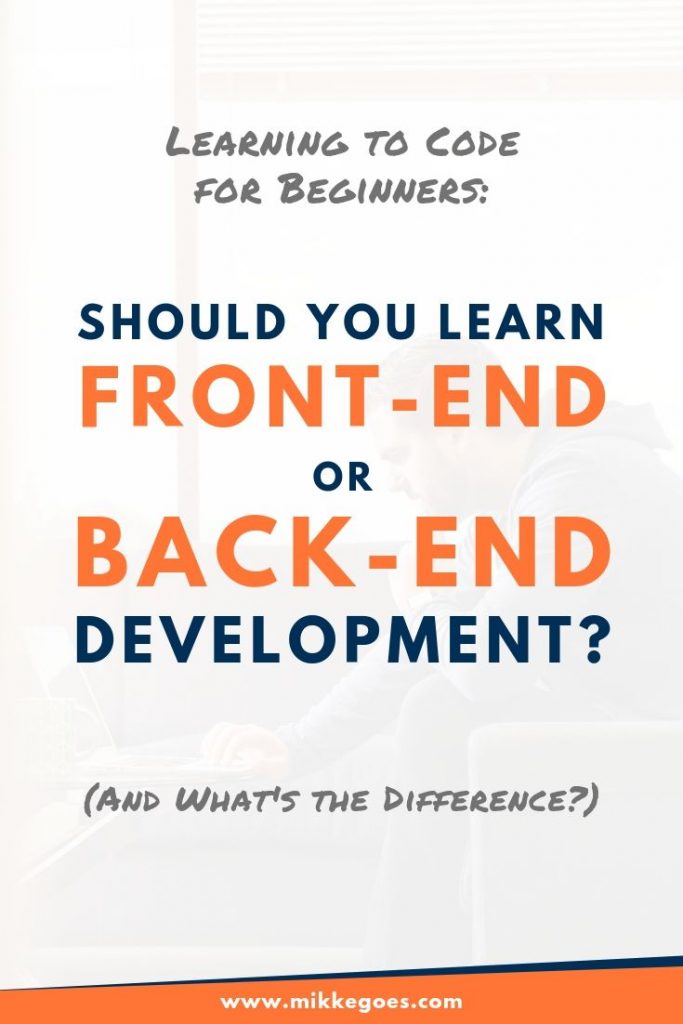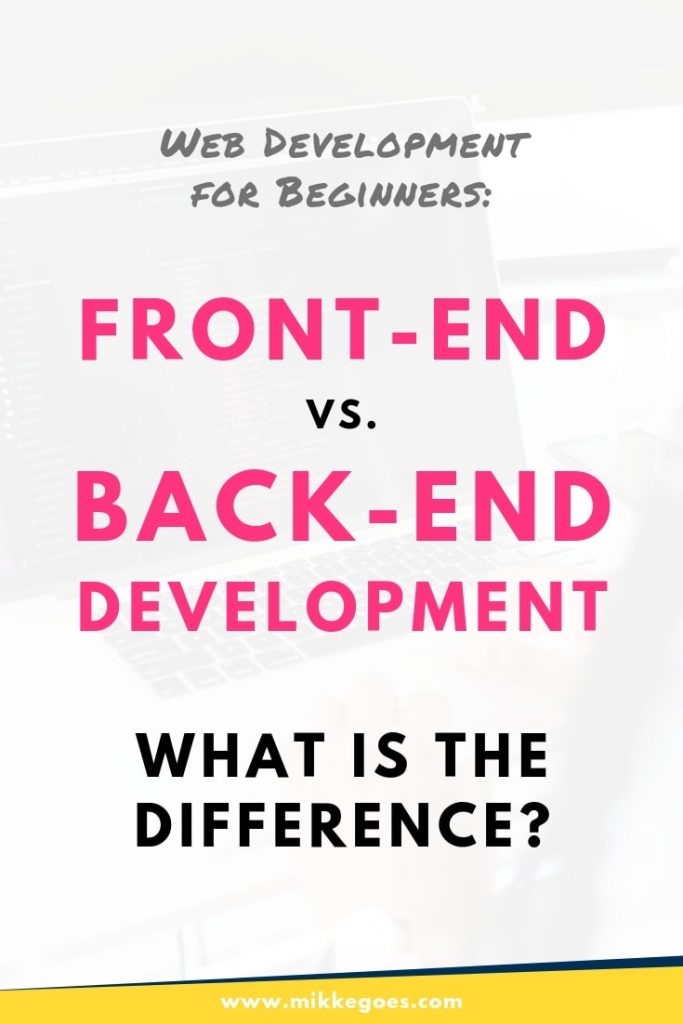You want to learn coding and web development, but you’re not sure what’s the difference between back-end development vs frond-end development? How can you learn the skills to specialize in either one of them?
Knowing what these two main specializations in web development are will help you learn the relevant programming languages and tools faster. If you want to start a career as a web developer, you should focus on either one of these areas.
Therefore, in this post we’ll go through the main differences between back-end and front-end development. We’ll look at what sorts of tasks they’re responsible for in website projects and find out what tools you need to learn to become a back-end or front-end web developer.
Keep reading!
Here are a few related posts you might want to read:
- The Best Way to Learn Coding – Beginner’s Guide
- How to Find the Easiest Programming Language for Beginners?
- 8 Critical Things to Know Before Learning Programming
Please note: This post contains affiliate links to products I use and recommend. I may receive a small commission if you purchase through one of my links, at no additional cost to you. Thank you for your support!
How do websites work?
Before we dive into the differences between back-end vs front-end development, let’s look at a few technicalities about how websites work.
Every time you visit a website, do you know what’s happening behind the scenes? Who’s responsible for making your favorite social network look and work the way it does?
Related: What Does a Web Developer Do Exactly?
Broadly speaking, each website you use has two different building blocks to it:
- How it looks on the outside
- How it works on the inside
The first part consists of everything that you see and interact with in your web browser. It’s what front-end developers are responsible for: colors, fonts, layouts, etc.
The second part is the logic and “brain” behind all of it. For example, when you log in on Facebook, the website needs to know whether it’s you who’s trying to log in. Your user data is stored on a web server, and it needs to be retrieved to see if your login credentials are correct.
This is what back-end developers build: the website features that are responsible for storing and retrieving data from users and showing the right information to the right users.
The biggest difference between the two specializations are the programming languages you need to learn. Thus, if you want to become a web developer, you need to choose your focus before you learn your first programming language.
Let’s take a look at both areas separately…
Recommended: What Programming Language Should I Learn? Beginner’s Guide

#1: Back-end development
These days, most websites show different content depending on who’s using the site. When you log in on a social network, you see your own posts and those of your friends in your feed.
But how does the website know who you’re friends with? And how does it remember everything you write and post? This is where back-end developers come into play.
Back-end developers use databases to store your data on a web server. A server is simply a computer that knows how to retrieve this data correctly when needed. To make things work properly, back-end developers build web applications to create the desired features for the website.
Thus, when you log in on your web browser, the server receives a request from your browser. The request says you’d like to log in and see your feed or homepage. Then, the database retrieves the right data and sends it back to your browser, and you see a welcome message on your screen.
Recommended: How Does the Internet Work? Free Coding Guide for Beginners
Tools for back-end development
The programming languages used by back-end developers focus on database management and the different dynamics and functionalities of a website. These are often called server-side languages.
Here are a few of the most popular and best programming languages for web development:
- PHP
- Python
- Ruby
- Java
Additionally, back-end developers use a language called SQL to store and manage user information in databases. Thus, the scripts and code written in any of the languages above works together seamlessly with a database management tool like MySQL or PostgreSQL.
Related: 10 Powerful Tips to Learn Coding More Efficiently
Example of a back-end design pattern
When I started learning to code, I often had a hard time understanding how everything works on the back-end. It’s sometimes just a tad too abstract, and that’s totally normal.
To help you wrap your head around all of it, let’s consider a more practical example. Let’s say you’re at the shoe store, for instance:
- You know exactly the pair you’re looking for, so you tell the salesperson what you’d like to buy. They’re the person you interact with, so it’s like the front-end on a website, right?
- Now, the front-end doesn’t really know what to do. It just looks pretty and isn’t too bright, so it needs to ask their boss what to do.
- But the boss, on the other hand, is only good at telling others what to do. (You can probably think of a real-life example of a boss like that!)
- So, the boss finds the smartest and fastest employee to get the pair of shoes you want to buy. So they run into the back room to get the shoes for you.
- Finally, the salesperson gets the product and presents it to you. Again, that’s just the interface you’re interacting with.
Although this is a rather complex pattern, it’s one of the most common design patterns for back-end development. To be more exact, we’re talking about the so-called Model-View-Controller pattern (MVC) here.
Let’s sum it up real quick from our example above:
- The model is the smart employee in the back room
- The view is the pretty salesperson
- The controller is the bossy supervisor
For more details, check out my article on the MVC design pattern.
There’s another great explanation on how the MVC works on YouTube. It’s a part of the CS50 course of Harvard College.
#2: Front-end development
Storing user data is cool and all, but what makes your favorite websites look good then?
Front-end developers create the look and feel of every page you visit. They are responsible for the part of a webpage you see and interact with directly.
It’s also their job to consider the brand identity and the emotional experience the website wishes to convey to their end users. Alternatively, this aspect of web projects is also called web design.
Tools for front-end development
As for the markup and programming languages used by front-end developers, their main tools are:
HTML creates the actual content and structure of a web page, such as text, links, lists, tables, images, and other media. Then, CSS is used to make all this look more beautiful and appealing to the user. Finally, JavaScript allows front-end developers to add interactive and responsive elements to the website.
Here’s a helpful post about the essential tools you should learn to become a front-end web developer – check it out!
Related: The Best HTML and CSS Courses for Beginners
Full-stack development – combining both areas
A full-stack developer masters both aspects of creating and maintaining a website. In fact, sometimes it’s even not that black and white with the division into back-end and front-end sides of a project. Each one needs to understand what the other one can and will create.
In the future, web projects are only going to become more complex and diverse. Therefore, understanding both sides of the development process is an invaluable asset to have.
Thus, if you can’t quite decide which area to specialize in, becoming a full-stack developer is a lucrative career option. Most often, full-stack developers become team leaders since they know how to manage an entire team of front-end and back-end developers.
Final thoughts: Back-end Development vs Front-end Development
In short, back-end development stores and organises data. It sends and receives data, enabling websites to be more dynamic than those using only front-end development tools.
As I pointed out before, the two areas differ from one another in terms of the programming languages used.
Even though there is a clear distinction between back-end development vs front-end development on a web projects, the two are ultimately just two sides of the same coin. So whatever you’re interested in with web projects, you’ll get to know both sides.
To get started with learning the right tools, check out my article with the best websites to learn coding and web development from scratch! I’ll see you there!
Here are a few helpful posts you might want to read:
- 5 Awesome Web Development Courses for Beginners
- How to Make Money Coding? 4 Ways to Make Money as a Developer
- Web Developer Salary: How Much Web Developers Make in 2019
If you enjoyed this post about the difference between back-end development vs front-end development, just drop me a line in the comments below!
P.S. If you found this article helpful, please share it with others! Thanks for your support!
Happy coding!
– Mikke


